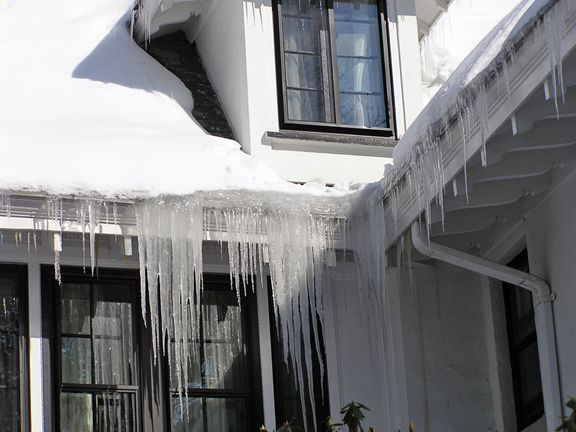
Ice Dam and Snow Removal
- Category: Ice Dams
- Written by Administrator
Ice dam prevention with snow removal.

If you know, from prior years of experience, that you may have a problem with ice dams and have not yet solved the underlying issues, short term ice dam prevention can be accomplished by removing the snow from your roof before the ice dam forms.
First, removing snow from a roof can be quite dangerous so it may be best left to a professional roofer.
Looking around your neighborhood often you will see that on many roofs the lower edge of the roof by the gutter is the only area cleared. This could be because the owner could only reach the lower edge of the roof with a short handled snow rake without climbing up on a ladder.
Sometimes just removing the snow from the lower edge of the roof is enough. Much heat loss from a residential building occurs at the eaves, or lower edge of the roof, due to insulation and air leak issues where the walls meet the roof.
This area can be warmer than the rest of the roof and be causing most of the problem. Removing the snow from the roof eave removes the possibility of that snow melting and cools that area preventing melting of residual snow.
Of course, depending on weather and roof design, the snow above this area can still melt and run down to the gutter, freezing and building up into an ice dam.
If possible, always remove the snow from the entire roof area above the ice dam. Remove the snow soon after it begins to build up on the roof. If it is allowed to sit for long the snow begins to pack down which makes it harder to remove. If the snow is fresh and fluffy, you can reach farther up the roof with your snow rake and pull larger amounts of snow. If the snow is heavy or begun to pack down, remove a little at a time from the lowest edge of the snow pack. Pulling small batches of snow over the already cleared lower roofing. Slowly working your way up through the snow pack to the peak of the roof.
Do not rake all the way to the roofing shingles. Roofing shingles become very brittle in cold winter temperatures, and it is very easy to scrape off the protective granules from the shingle, or worse, tear or break the shingles. Always stop short and leave a thin layer of snow on the roof.
Dark colored shingles can be a plus or a minus. If you can get most of the snow off of dark colored shingles, sunlight can warm them to help melt the rest of the snow. This is good if there is enough sunlight to completely melt the snow and dry the shingles. But, if there is a little sunlight, then clouds and cold temperatures, the melted snow will quickly turn to ice. Light colored shingles on the other hand will reflect the sun and keep the shingles cooler.
Removing all the snow from the roof area above the ice dam is usually the best option. Also the hardest and most expensive.


